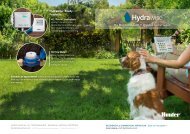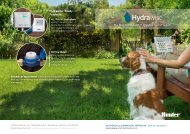Hunter Residential Sprinkler System / Irrigation system design guide - Calgary irrigation
Residential Irrigation Service and Design Guide for underground sprinklers. Learn how to design, install, service, repair and winterize your underground sprinkler system. Irrigation Calgary. Lawn irrigation. Underground sprinklers Calgary
Residential Irrigation Service and Design Guide for underground sprinklers. Learn how to design, install, service, repair and winterize your underground sprinkler system. Irrigation Calgary. Lawn irrigation. Underground sprinklers Calgary
Create successful ePaper yourself
Turn your PDF publications into a flip-book with our unique Google optimized e-Paper software.
SYSTEM INSTALLATION<br />
Installing Sensors<br />
Weather–based sensors are available in a variety of<br />
sensor types and combinations including rain, freeze,<br />
and ET (evapotranspiration) based sensors. Rain and<br />
freeze sensors simply stop or prevent <strong>irrigation</strong> in the<br />
event of rainfall or freeze conditions. ET sensors calculate<br />
the amount of water needed by the plant material<br />
and adjust run times automatically based on current<br />
weather conditions.<br />
Solar Sync ®<br />
ET weather sensor with rain<br />
and freeze shutdown.<br />
Mounting Suggestions<br />
1. Rain sensors should be installed where they can receive<br />
direct rainfall, such as on the edge of a roof, a rain gutter,<br />
or on a fence post. Make sure they are not located under<br />
trees or other plant material and they are not getting<br />
wet within the sprinkler spray pattern.<br />
Rain–Clik ®<br />
Shuts down <strong>irrigation</strong> during<br />
a rain or freeze event.<br />
2. Freeze sensors will stop or prevent <strong>irrigation</strong> at<br />
or below 3 degrees Celsius. The sensor will reactivate the<br />
<strong>system</strong> when temperatures are between 3-7°C.<br />
3. Weather–based ET sensors should receive as many<br />
hours of direct sunlight during the day and throughout<br />
the year as possible.<br />
Communication Options<br />
1. Wired communication: Sensors are attached to the<br />
controller sensor inputs directly with two wires from<br />
the sensor. Care should be taken to carefully install and<br />
attach the wire path without damaging the wire.<br />
2. Wireless communication: Sensors have a battery–<br />
operated transmitter within the sensor that sends data<br />
to the receiver attached to the controller. Wireless<br />
communication affords more options for mounting the<br />
sensor but ensure you have reception from the proposed<br />
mounting location. Also, be aware of high-voltage<br />
sources of interference that may cause difficulty in<br />
reception. Ensure you test the sensor/transmitter at the<br />
mounting location for proper reception to the receiver to<br />
avoid connectivity difficulties in the future.<br />
3. Flow meter communication: Flow meters are attached to<br />
the controller sensor inputs directly with two wires from<br />
the sensor. Flow meters are installed between the water<br />
supply and the master valve. To avoid false alerts, there<br />
should be no water taps or other uncontrolled water use<br />
on the downstream side of the flow meter. Where all the<br />
solenoids connected to the controller are not grouped<br />
together, it may be necessary to install more than one<br />
flow meter. Where the flow meter is installed, do not<br />
have 90 degree bends within approximately 30 cm of<br />
either side of the flow meter.<br />
Mini–Clik ®<br />
Shuts down <strong>irrigation</strong> at<br />
desired rainfall amount.<br />
Soil–Clik ®<br />
Responds as a shut-off<br />
device when the user<br />
selected soil moisture<br />
threshold is surpassed.<br />
HC Flow Meter<br />
Monitor your water use<br />
and the state of your<br />
piping <strong>system</strong> with the<br />
optional flow meter.<br />
Receive automatic alerts<br />
when a pipe is broken or<br />
leak has occurred before<br />
it becomes a problem.<br />
RESIDENTIAL SPRINKLER SYSTEM Design Guide<br />
19





